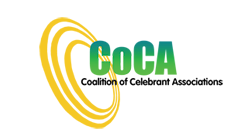SMEG: Suggested Approach to Assessment and Evidence Requirements for Selected Celebrancy Units of Competency
CHCCEL001 Develop sustainable celebrancy practice
Suggested assessment activities:
• Researched and assessed the perceptions of independent civil celebrants held by
(a) a minimum of ten (10) wedding industry suppliers
(b) a minimum of ten (10) funeral industry suppliers
(c) a minimum of five (5) hairdressers whose work has involved bridal parties
considering
(a) what evidence they have for their views
(b) how they would define a “professional” celebrant and what the celebrant would need to do to meet their definitions
• Conducted a survey of a minimum of ten (10) people from each of the following age groups
0-12; 13-17, 18 to 25, 26 -45, 46- 60, 61- 75, 76+
to document their perceptions of a range of ceremonies they have attended - weddings, namings/christenings, schools ceremonies and formals, birthdays, anniversaries, funerals and memorials, considering:
a) what they liked most
b) what they liked least
c) what things inspired them and/or touched their hearts
d) whether they know an independent celebrant and what they think about this role in the community
• Conducted a survey of a minimum of ten (10) celebrants from each of the following time frames
(a) Pre 1980
(b) 1980 to 1995
(c) 1995 to 2003
(d) 2003 to 2010
(e) 2010 to now
by doing an advance search of the AGD website section titled “Find a Celebrant” considering the following topics:
A. Commonwealth Marriage Celebrant Program
a) to identify the main characteristics of the Commonwealth Marriage Celebrant Program in that era
b) what the celebrants valued about that period
c) what those celebrants value about today’s Commonwealth Marriage Celebrant Program
d) how many marriages they have conducted
e) what they think their couples value
f) what their tips would be for new celebrants if they are willing to share those
B. Other ceremonies
a) how many other ceremonies they have conducted
b) the types of other ceremonies they have conducted
c) what they think their couples or families value
d) in what way they think civil celebrants have influenced Australian society
• Prepared a discussion document on:
(a) the meaning of the following concepts:
- Profession
- Business
- Private Practice
- Self-employed
- Employed
- Contractor
- Work
- Trade
- Professional
(b) the similarities and differences between these terms above
(c) the value judgments attached to these different terms and reasons for the ways language is blurring the terminology
- what they see as the key components for sustainable professional private practice
- what they believe are the major challenges small businesses face when getting set up
- how changing technologies have affected small business
- any advice they can provide for a person starting out in private practice /as a sole trader small business
- any courses, resources or support they provide
- their views about the advantages and disadvantages of networking and collaboration with other local businesses in the same field and in different but associated fields
- what proportion of income they would normally suggest be devoted to advertising and marketing
- their own celebrancy practice goals
- the evidence acquired in this unit which will help to support sustainable celebrancy practice goals, especially the population demographic of their own local geographic area, and how that compares with the national profile
- the range of ceremonial related services and products already available in their local area
- their planned approach to their own celebrancy practice, including how they will deal with contingencies – e.g. unavailability for a ceremony booking, how to build up a network of alternative celebrants if unable to perform celebrant services e.g. illness, accident, family needs etc.
- the ten (10) most important values they subscribe to in life which they would like to see reflected in their celebrancy practice
- their choice from any of the following which they would see as symbolic of themselves, their personality, and their celebrancy persona, and which symbols and metaphors they might subsequently use in their celebrancy practice (e.g. business card, letterhead, website, jewellery or feature of their celebrancy or ceremonial presentation)
• a flower
• a plant
• a mammal
• a bird
• a water creature
• a rock
• a gemstone - the ways in which their choices in parts (e) and (f) (above) clarify their perceptions of themselves, their attributes, skills and drives
- the strengths and assets that they believe they will bring as an independent civil celebrant to ceremony and celebration for the couples and families they plan to serve as civil celebrants or as religious celebrants


